
Agricultural and construction machinery company Deere (NYSE:DE) missed Wall Street’s revenue expectations in Q4 CY2024, with sales falling 18.9% year on year to $8.51 billion. Its GAAP profit of $3.19 per share was 1.8% below analysts’ consensus estimates.
Is now the time to buy Deere? Find out in our full research report .
Deere (DE) Q4 CY2024 Highlights:
Company Overview
Revolutionizing agriculture with the first self-polishing cast-steel plow in the 1800s, Deere (NYSE:DE) manufactures and distributes advanced agricultural, construction, forestry, and turf care equipment.
Agricultural Machinery
Agricultural machinery companies are investing to develop and produce more precise machinery, automated systems, and connected equipment that collects analyzable data to help farmers and other customers improve yields and increase efficiency. On the other hand, agriculture is seasonal and natural disasters or bad weather can impact the entire industry. Additionally, macroeconomic factors such as commodity prices or changes in interest rates–which dictate the willingness of these companies or their customers to invest–can impact demand for agricultural machinery.
Sales Growth
Examining a company’s long-term performance can provide clues about its quality. Any business can put up a good quarter or two, but the best consistently grow over the long haul. Unfortunately, Deere’s 4.4% annualized revenue growth over the last five years was sluggish. This was below our standard for the industrials sector and is a rough starting point for our analysis.
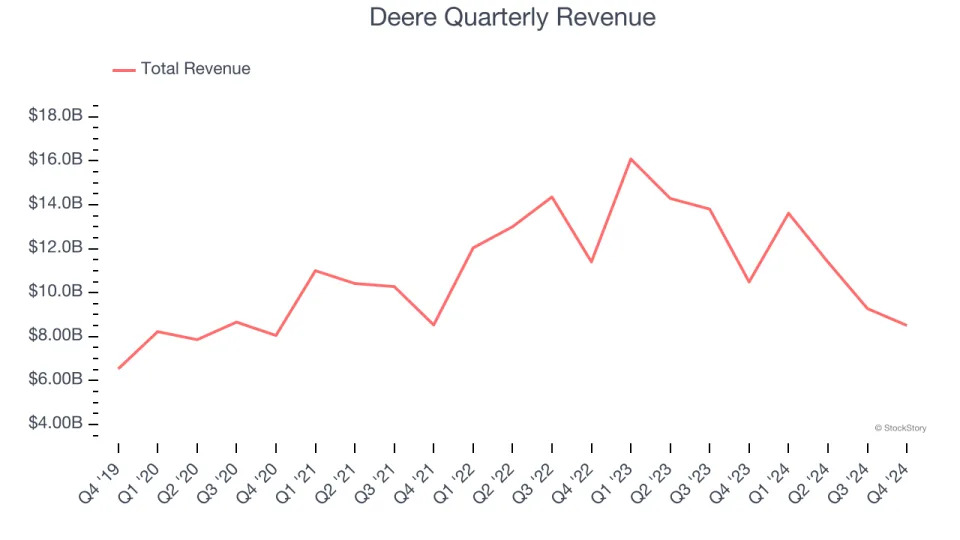
Long-term growth is the most important, but within industrials, a half-decade historical view may miss new industry trends or demand cycles. Deere’s history shows it grew in the past but relinquished its gains over the last two years, as its revenue fell by 8.2% annually.
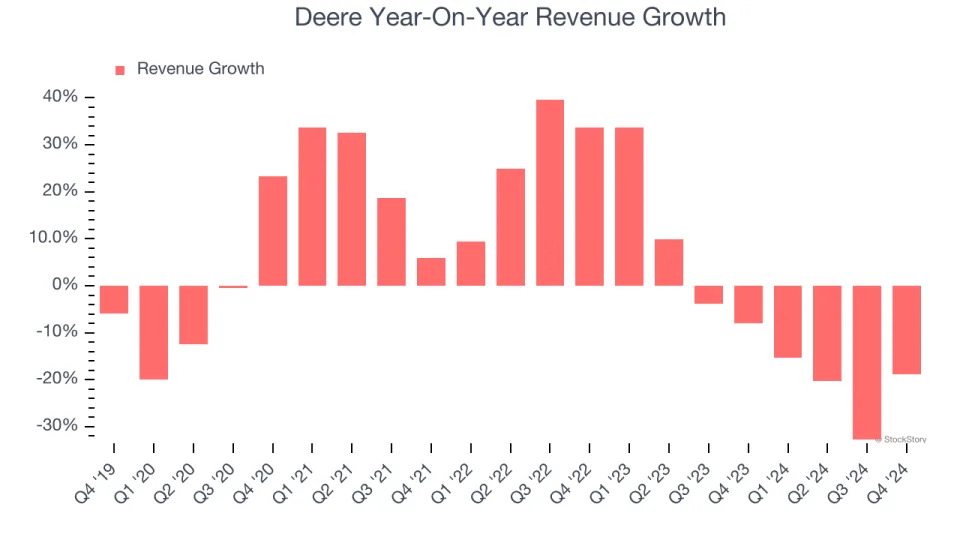
We can dig further into the company’s revenue dynamics by analyzing its three most important segments: Production & Precision Agriculture , Construction & Forestry , and Small Agriculture & Turf, which are 36%, 23.4%, and 20.5% of revenue. Over the last two years, Deere’s revenues in all three segments declined. Its Production & Precision Agriculture revenue (tractors, harvesters, tillage) averaged year-on-year decreases of 36.7% while its Construction & Forestry (loaders, excavators, dump trucks) and Small Agriculture & Turf (mowers and other small vehicles) revenues averaged drops of 4.8% and 13.5%.
This quarter, Deere missed Wall Street’s estimates and reported a rather uninspiring 18.9% year-on-year revenue decline, generating $8.51 billion of revenue.
Looking ahead, sell-side analysts expect revenue to grow 5.7% over the next 12 months. Although this projection suggests its newer products and services will fuel better top-line performance, it is still below the sector average.
Unless you’ve been living under a rock, it should be obvious by now that generative AI is going to have a huge impact on how large corporations do business. While Nvidia and AMD are trading close to all-time highs, we prefer a lesser-known (but still profitable) stock benefiting from the rise of AI. .
Operating Margin
Deere has been a well-oiled machine over the last five years. It demonstrated elite profitability for an industrials business, boasting an average operating margin of 20.3%.
Analyzing the trend in its profitability, Deere’s operating margin rose by 3.9 percentage points over the last five years, showing its efficiency has improved.
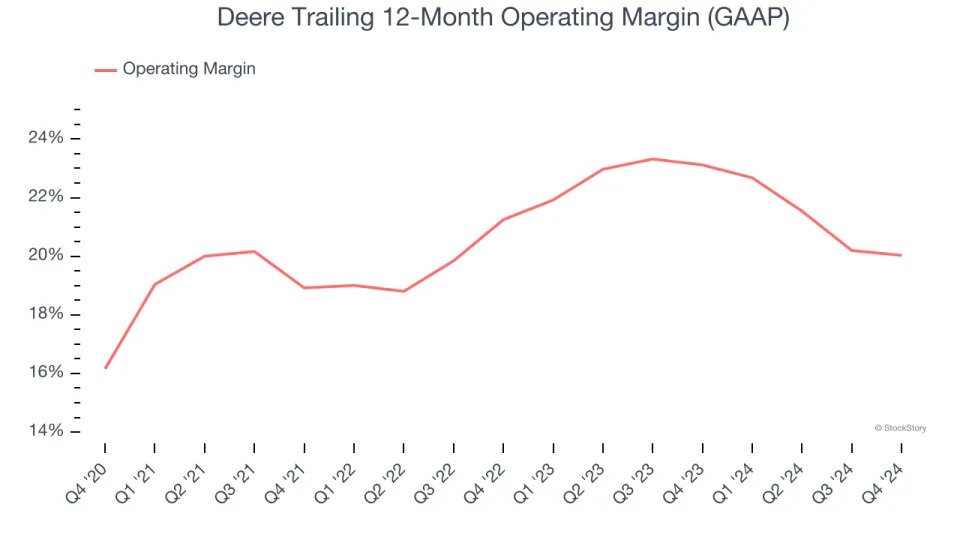
This quarter, Deere generated an operating profit margin of 20.3%, in line with the same quarter last year. This indicates the company’s overall cost structure has been relatively stable.
Earnings Per Share
Revenue trends explain a company’s historical growth, but the long-term change in earnings per share (EPS) points to the profitability of that growth – for example, a company could inflate its sales through excessive spending on advertising and promotions.
Deere’s EPS grew at a spectacular 17.1% compounded annual growth rate over the last five years, higher than its 4.4% annualized revenue growth. This tells us the company became more profitable on a per-share basis as it expanded.
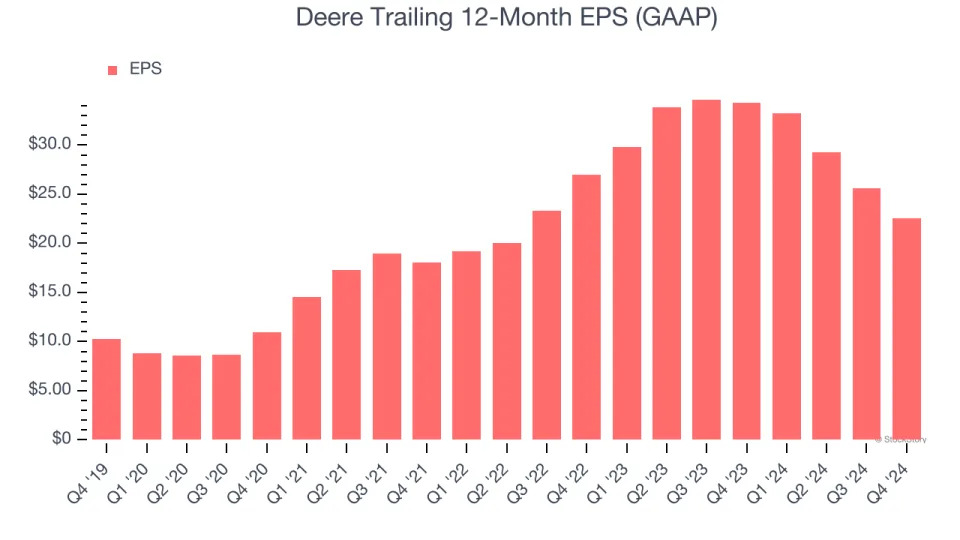
Diving into the nuances of Deere’s earnings can give us a better understanding of its performance. As we mentioned earlier, Deere’s operating margin was flat this quarter but expanded by 3.9 percentage points over the last five years. On top of that, its share count shrank by 14.2%. These are positive signs for shareholders because improving profitability and share buybacks turbocharge EPS growth relative to revenue growth.
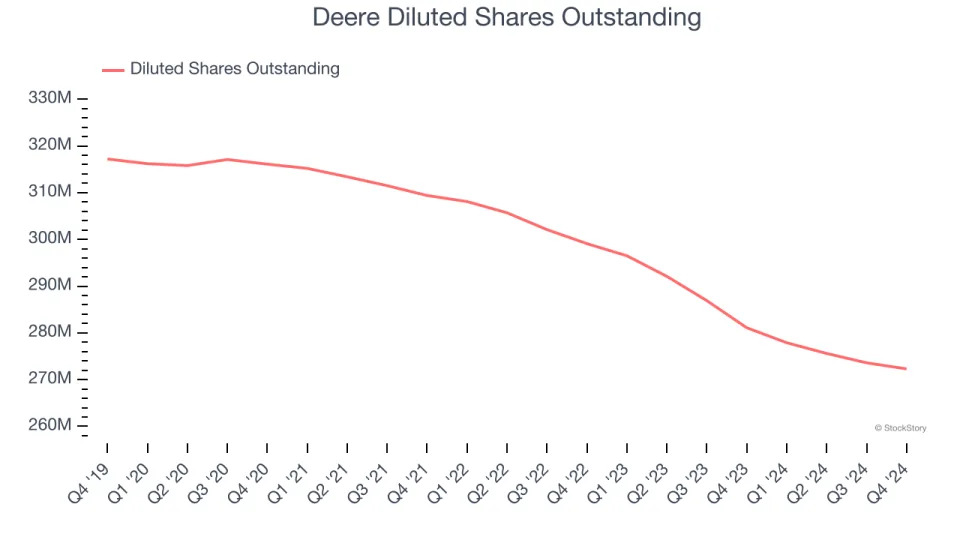
Like with revenue, we analyze EPS over a shorter period to see if we are missing a change in the business.
For Deere, its two-year annual EPS declines of 8.5% mark a reversal from its (seemingly) healthy five-year trend. We hope Deere can return to earnings growth in the future.
In Q4, Deere reported EPS at $3.19, down from $6.23 in the same quarter last year. This print slightly missed analysts’ estimates, but we care more about long-term EPS growth than short-term movements. Over the next 12 months, Wall Street expects Deere’s full-year EPS of $22.56 to shrink by 10.5%.
Key Takeaways from Deere’s Q4 Results
We struggled to find many positives in these results. Its and its revenue fell short of Wall Street’s estimates. Overall, this was a weaker quarter. The stock traded down 8.2% to $437.50 immediately after reporting.
Deere underperformed this quarter, but does that create an opportunity to invest right now? When making that decision, it’s important to consider its valuation, business qualities, as well as what has happened in the latest quarter. We cover that in our actionable full research report which you can read here, it’s free .





